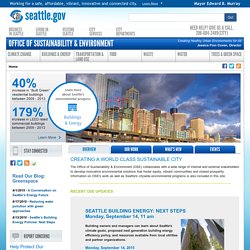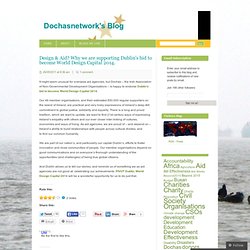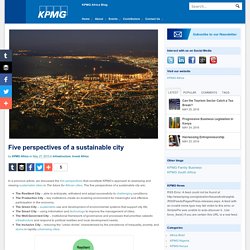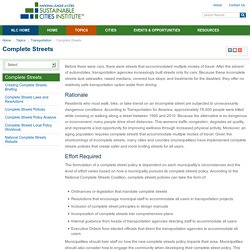

The Day Before Tomorrow - Episode 3 - Smart Cities. Sustainability: Game human nature. Illustration by Greygouar Hundreds of studies in behavioural economics and other social sciences, conducted over the past few decades, have established that people often make choices that take into account the well-being of others.

This contradicts an assumption held over centuries that people exclusively pursue their own material well-being. It also offers hope for the prospect of developing public goods (see ‘Glossary: behavioural economics’) that will benefit future generations. Glossary: Behavioural economics. Office of Sustainability & Environment - Seattle. The Office of Sustainability & Environment (OSE) collaborates with a wide range of internal and external stakeholders to develop innovative environmental solutions that foster equity, vibrant communities and shared prosperity.

Information on OSE's work as well as Seattle's citywide environmental programs is also included in this site SEATTLE BUILDING ENERGY: NEXT STEPSMonday, September 14, 11 am Building owners and managers can learn about Seattle's climate goals, proposed next generation building energy efficiency policy, and resources available from local utilities and partner organizations.
Monday, September 14, 2015 11 am to 1 pm Bertha Knight Landes RoomSeattle City Hall - 600 4th Ave. More information on this work here. The Office of Sustainability and Environment delivers cutting-edge policies and effective programs to address Seattle's environmental challenges while creating vibrant communities and building shared prosperity.
We develop and test forward-looking approaches. Kirkland Green - City of Kirkland. Kirkland is known for its green spaces, parks and waterfront.

The City is committed – through many “green" initiatives – to preserve, protect and sustain our natural resources. Through a variety of efforts, the City is also addressing sustainable development, green buildings and climate change. Kirkland recognizes the interdependency of our natural resource systems: Waste-Based Energy, Present and Future. Singapore Is On Its Way To Becoming An Iconic Smart City. This past week I had the pleasure of being invited to Singapore to present my research on smart, innovative cities.
Tropical greenspaces throughout the city are juxtaposed with remnants of its past through an authentic China Town, Little India and others--all of which mixes with a modern, robust, waterside financial district, as well as upscale, North-American-style malls and entertainment districts. That’s a lot for a small island with about 5 million inhabitants.
For those of us interested in smart city evolution, Singapore is a fascinating place to explore. I was lucky enough to have Andreas Birnik, the former director of smart cities for Ericsson and current adjunct professor of sustainability at the National University of Singapore, as a guide. Nearly 90% of the Singaporean population owns their own home or apartment. Singapore is definitely pushing the envelope on innovation in policy and infrastructure. On the sustainability side, Singapore generally gets very high marks. Cities are on the rise. Urbanites 2050. Rapid urbanization poses major development setback, says UN. Shanghai, China Trent McBride More than 6 billion people will live in cities by 2050 and the world is not prepared.

Development gains could be lost if steps are not taken today to deal with rapid urbanization, says the UN. The UN Department of Economic and Social Affairs World Economic and Social Survey 2013 warns that current trends could increase the number of people living in slums who do not have access to basic needs like sanitation, healthcare and electricity from one billion to three billion. “Rising inequalities, the food, fuel and financial crises, and the breaching of planetary boundaries have made clear that a mere continuation of current strategies will not suffice to achieve sustainable development after 2015,” say the report authors. Global population will grow from 7 billion today to 9 billion by 2050. The findings are a part of a closer look at the three drivers of sustainable development: economic, social and environmental.
Food security remains a problem. Cities, Design & Aid? 26/05/2011 at 9:36 am It might seem unusual for overseas aid agencies, but Dóchas – the Irish Association of Non-Governmental Development Organisations – is happy to endorse Dublin’s bid to become World Design Capital 2014.

Sustainable cities depend on empowered citizens. Building Sustainable Cities. Executive Summary Reprint: R1307B.

Five perspectives of a sustainable city - Blog KPMG Africa. In a previous article, we discussed the five perspectives that constitute KPMG’s approach to assessing and viewing sustainable cities in The future for African cities.

Complete Streets. Before there were cars, there were streets that accommodated multiple modes of travel.

After the advent of automobiles, transportation agencies increasingly built streets only for cars. Because these incomplete streets lack sidewalks, raised medians, covered bus stops, and treatments for the disabled, they offer no relatively safe transportation option aside from driving. Rationale Residents who must walk, bike, or take transit on an incomplete street are subjected to unnecessarily dangerous conditions. According to Transportation for America, approximately 76,000 people were killed while crossing or walking along a street between 1995 and 2010. Effort Required The formulation of a complete street policy is dependent on each municipality's circumstances and the level of effort varies based on how a municipality pursues its complete streets policy.
Municipalities should train staff on how the new complete streets policy impacts their area. Benefits Risks Costs.